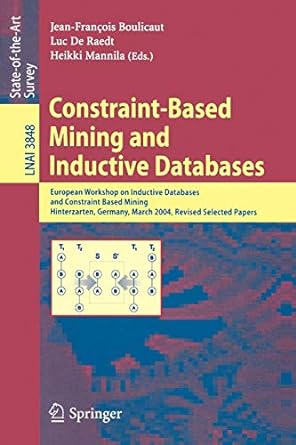Question
Function Requirements: Based on the source code for BST in linked lists below, please implement the following functions: Implement pre-order function and include it into
Function Requirements:
Based on the source code for BST in linked lists below, please implement the following functions:
Implement pre-order function and include it into the travasal function
Implement post-order function and include it into the travasal function
Implement search function so that the search path would be printed out from the root to the search target. For example, if we search 19, the output would be 5-8-9-18-20-19. Once the search code is done, un-comment the following codes in main function.
//t1->search(3);
//t1->search(18);
//t1->search(19);
Here is the code for BST in linked lists
#include
using namespace std;
class node
{
public:
int data;
node *left;
node *right;
};
class BST
{
public:
BST()
{
root = NULL;
}
void insert(int element)
{
node *newptr = new node;
newptr->data = element;
newptr->left = NULL;
newptr->right = NULL;
//cout << "Here" << endl;
if (root == NULL)
{
root = newptr;
}
else
{
node *p = root;
node *parent = NULL;
while ((p != NULL) && (p->data != element)) //find the right location for the new node
{
if (element < p->data)
{
parent = p;
p = p->left;
}
else
{
parent = p;
p = p->right;
}
}
if (p == NULL) //if the element is not in the BST
{
if (element < parent->data)
parent->left = newptr;
else
parent->right = newptr;
}
else
cout << "node duplicate!" << endl;
}
}
void remove(int element)
{
node *p = root;
node *parent = NULL;
while ((p != NULL) && (p->data != element)) //find the correct location for the new node
{
if (element < p->data)
{
parent = p;
p = p->left;
}
else
{
parent = p;
p = p->right;
}
}
if (p->left == NULL && p->right == NULL) //case 1
{
if (element < parent->data)
parent->left = NULL;
else
parent->right = NULL;
delete p;
}
else if (p->left != NULL && p->right == NULL) //case 2
{
if (element < parent->data)
parent->left = p->left;
else
parent->right = p->left;
delete p;
}
else if (p->left == NULL && p->right != NULL) //case 2
{
if (element < parent->data)
parent->left = p->right;
else
parent->right = p->right;
delete p;
}
else //case 3
{
int min_of_right_child = findmin(p->right);
remove(min_of_right_child);
p->data = min_of_right_child;
}
}
int findmin(node *p)
{
while (p->left != NULL)
p = p->left;
return p->data;
}
int findmax(node *p)
{
while (p->right != NULL)
p = p->right;
return p->data;
}
void inorder(node *p)
{
if (p != NULL)
{
inorder(p->left);
cout << p->data << " ";
inorder(p->right);
}
}
void travasal()
{
cout << " Min value: "< cout << " Max value: " << findmax(root); cout << endl; cout << " Inorder: "; inorder(root); // include pre-order & post-order function cout << endl; cout << endl; } private: node *root; }; void main() { BST *t1 = new BST(); t1->insert(5); t1->insert(8); t1->insert(3); t1->insert(1); t1->insert(4); t1->insert(9); t1->insert(18); t1->insert(20); t1->insert(19); t1->insert(2); t1->travasal(); //t1->search(3); //t1->search(18); //t1->search(19); t1->remove(9); t1->travasal(); t1->remove(2); t1->travasal(); t1->remove(8); t1->travasal(); t1->remove(3); t1->travasal(); t1->remove(5); t1->travasal(); }
Step by Step Solution
There are 3 Steps involved in it
Step: 1

Get Instant Access to Expert-Tailored Solutions
See step-by-step solutions with expert insights and AI powered tools for academic success
Step: 2

Step: 3

Ace Your Homework with AI
Get the answers you need in no time with our AI-driven, step-by-step assistance
Get Started


